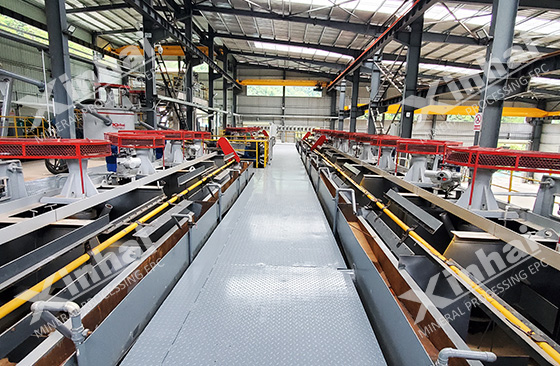There are many kinds of gold ores in the nature, and the beneficiation methods chosen for different types are naturally different. Among them, the commonly used beneficiation method in rock gold mines is mainly flotation. The flotation method can process poor sulfide gold ores, high sulfide gold ores and associated polymetallic gold-bearing ores. It can effectively separate various gold-bearing sulfide concentrates. The commonly used method is the priority flotation process to directly float out gold-bearing sulfide ores. In addition, flotation is also an indispensable method for treating refractory gold- and silver-containing ores that are difficult to directly mix with mercury and cyanide. In production practice, the appropriate flotation process can be selected based on the properties of gold and silver ores and product requirements. The following will introduce you to several gold ore flotation processes.
Use the table of contents below to navigate through the guide:
01Gold ore flotation+concentrate cyanidation process
This method is suitable for processing quartz vein sulfide ores containing gold and silver ores. Sulfide ore is flotated to obtain a small amount of concentrate, which is then cyanided. Compared with the all-sludge cyanidation process, the flotation concentrate cyanidation process does not require all the ores to be finely ground, which can save grinding costs and power energy consumption. This process also has the advantages of small footprint and capital cost.

02Gold ore flotation+concentrate thiourea leaching process
This process is suitable for processing vein gold ores that contain high arsenic, sulfur, or carbon-rich mud. First, a flotation process is used to obtain gold-containing sulfide mineral concentrate, and then thiourea is used to leach the concentrate to recover gold. The thiourea leaching process is simple and easy to operate. It also has the advantages of fast leaching speed and low toxicity. Thiourea leaching method has high leaching rate and low consumption of chemicals and materials when processing gold concentrates with high arsenic, sulfur, carbonaceous or muddy contents.
03Gold ore flotation+concentrate roasting+roasting and cyanidation process
This process is mainly used to process refractory gold-bearing arsenic ores, gold-bearing antimony ores and high-sulfur gold-pyrite ores. Roasting is used in the process to remove elements harmful to the cyanidation process, such as arsenic and antimony.

04Gold mine mercury amalgamation+flotation process
This process can be used to process vein gold ore with uneven thickness. In the grinding circuit, the mercury amalgamation method is used to recover the coarse-grained gold in the ore, and then the flotation method is used to recover the fine-grained gold. This approach can increase gold recovery and reduce overall beneficiation costs.
05Gold ore flotation+concentrate pyrolysis process
This method can be applied to the separation of most polymetallic sulfide ores containing gold and silver. When flotating gold ore, gold and silver will enter the copper-lead and other gold ores that are closely symbiotic with it, and then can be sent to the smelting plant for recovery of gold and silver.

06Gold ore flotation+concentrate roasting, tailings medium ore cyanidation process
Quartz sulfide ores containing telluride, pyrrhotite, chalcopyrite and other sulfide minerals can be treated with this scheme. The sulfide ore floating out of the ore is used as concentrate, and then the roasting method is used to expose the gold and silver in the sulfide ore, followed by cyanidation treatment. Since the middlings and tailings obtained after flotation also contain gold and silver, they need to be recovered using a cyanidation process.
07Gold ore cyanidation + tailings flotation process flow
This process is mainly applicable when the cyanidation process cannot fully recover the gold and silver that are symbiotic with sulfide in the ore. Selecting the tailings treated by the cyanidation process for flotation can further improve the utilization rate of gold mines and the recovery rate of concentrates.

The above is a brief introduction to several gold ore flotation processes. Since the characteristics of each medium-sized gold ore are different, the applicable mineral processing methods are also different, so the amnestic mineral processing technology should be selected according to the characteristics of the ore. When choosing a gold ore beneficiation process, attention should be paid to early recovery of large gold particles, mud and sand sorting, stage grinding, stage separation and the use of combined processes. Xinhai Mining recommends conducting mineral processing tests. Based on the test results and production requirements, a customized gold mineral processing plan can be designed to effectively recover gold particles in the ore and improve the concentrate recovery rate and economic benefits.


 marketing@ytxinhai.com
marketing@ytxinhai.com  0086 13810327080
0086 13810327080 






































































































 CHAT
CHAT MESSAGE
MESSAGE






